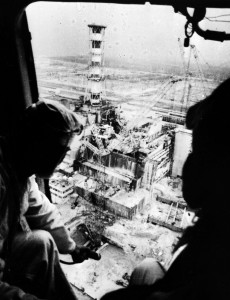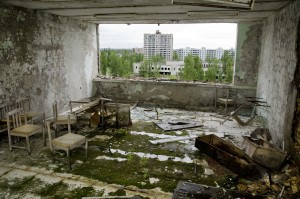Chernobyl: Looking Back Over 30 Years
On Saturday, April 26, 1986, at approximately 1:24 a.m., Reactor No. 4 at the V. I. Lenin Atomic Power Station near Chernobyl, Ukraine, exploded. First, a steam explosion blew a one-thousand-ton plate off the top of the reactor. Two or three seconds later, a second hydrogen gas explosion followed. Massive quantities of radioactive particles and gases were expelled into the atmosphere. Valery Khodomchuk, an operator standing near the reactor core, died instantly. A second operator, Vladimir Shashenka, was close to the reactor hall. He was found alive, but died within hours.
Through a series of negligent actions and omission, the government created the worst nuclear disaster in history. Deficiencies in plant design (there was no containment system), improper clearance for operation (without completing safety checks), and testing of the backup power supply started the disaster. Further failures prolonged and deepened the risks. A lack of appropriate warnings and safety systems for rescue personnel — fire ladders that did not reach the roof, a roof made of bitumen, inadequate monitoring equipment and protective clothing — forced them to endure direct exposure to radiation. Many did not endure.
AP
The rescue workers were known as liquidators, because they liquidated the fire before it got worse. In the saddest sense of irony, many of them were themselves liquidated.
The failure to timely warn the people of nearby Pripyat exposed more people to needless risk from radiation. With no warning, the people of Pripyat went about their daily chores, outside, unable to imagine what dangers were lurking in the fire that seemed to be engulfing the nuclear power plant nearby. Some pretended that it was nothing, others belittled those who expressed anxiety. When evacuation came to the people in the area of Chernobyl, it was hurried and people had little time to gather their lives. The relocation was traumatic. These environmental refugees had to leave their belongings behind, including the graves of loved ones. Despite the restrictions, some older people secretly returned to the exclusion zone choosing to die in homes they had always known rather than to live in strange, unfamiliar surroundings.
Magnum
Meanwhile radioactive clouds that formed from the release traveled throughout Europe spreading radioactive elements in their path, threatening millions. Suppressing the reality of what was happening at Chernobyl extended the risk to people throughout Europe. Without full disclosure from the Russian government, people and governments throughout Europe could only speculate what risks they faced, and what they could do to protect themselves. There was little confidence that the Russian government was doing or was capable of doing what was necessary to protect anyone. The world-wide fear about the effects from Chernobyl derived not only from the scope of the radiation risks, but from the deep anxiety when no one could assure people of the full nature of the risk.
To avoid some relocations, the government simply redefined what constituted a risky area. The safe level of contaminants in reindeer was changed so that reindeer, a staple for Sami societies, did not have to be slaughtered. A part of the exclusion zone was renamed as an ecological reserve instead of cleaning it. Playing with language is a form of risk management that most often is used to obfuscate rather than to reveal what is happening. It also saves the governments considerable remediation costs. The long-term costs to those who were not relocated or continued to eat the reindeer meat remain unknown.
At Chernobyl, the earliest expectations were that many would die or contract severe illnesses from the radiation exposure. Eighty-four miles south of Chernobyl, in Kiev, fallen leaves were removed and buried between layers of clay and people known as “catastrophists” were observed walking around on bright sunny days covered from head to toe in old clothes, caps, gloves, and stockings.
When the direst predictions did not materialize many relaxed and congratulated themselves on escaping the worst. Yet as so often happens in environmental disasters, with exposure to low levels of toxic substances, comfort can be short lived. No one learned that lesson better that the very young who have developed thyroid cancer, some from radiation exposure in the womb, and their parents and loved ones who have had to bear witness to their suffering.
Thousands died from the disaster, and thousands of children suffered thyroid cancer from exposure to the radioactive material. An area 30 kilometers (18 miles) around Chernobyl remains to this day dead from radioactive material, and the nuclear reactor continues to pose a significant threat.
Chernobyl was the world’s worst environmental disaster, until global climate change.
Postscript:
Many thought, hoped, pretended that there would never be a nuclear disaster like Chernobyl. Yet in March 2011, just 5 years ago and 25 years after Chernobyl, we witnessed the nuclear disaster in Fukushima, Japan. That disaster continues to unfold.
We have had four nuclear disasters in the past 70 years — Windscale/Sellafield in the UK (1957), Three Mile Island in the US (1979), Chernobyl in Belarus (1986), and Fukishima in Japan (2011). One nearly every 20 years, almost once a generation. When someone tries to dismiss the risks from nuclear power, remind them of what happened over just the past 30 years at Chernobyl and Fukushima.
Adapted from “Chernobyl,” in Robert Emmet Hernan, This Borrowed Earth: Lessons From the 15 Worst Environmental Disasters Around the World (published in English by Palgrave Macmillan, 2010, and in Chinese by China Machine Press, 2011. www.environmentaldisasters.info/environmentaldisasters.info/Contents.html




No comments yet, add your own below